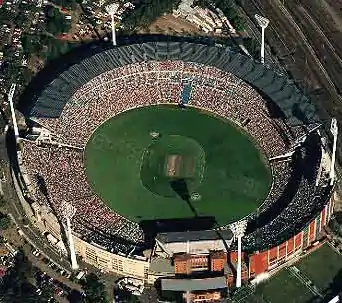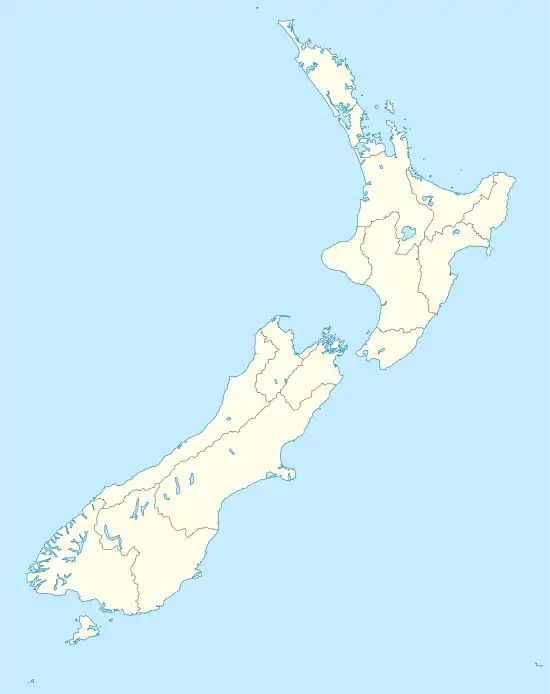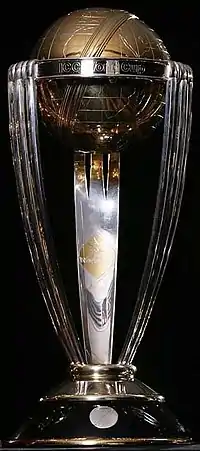1992 Cricket World Cup
The 1992 Cricket World Cup (officially the Benson & Hedges World Cup 1992) was the fifth staging of the Cricket World Cup, organised by the International Cricket Council (ICC). It was held in Australia and New Zealand from 22 February to 25 March 1992, and finished with Pakistan beating England by 22 runs in the final to become the World Cup champions for the first time.
 | |
| Dates | 22 February – 25 March |
|---|---|
| Administrator(s) | International Cricket Council |
| Cricket format | One Day International |
| Tournament format(s) | Round-robin and Knockout |
| Host(s) | |
| Champions | |
| Runners-up | |
| Participants | 9 |
| Matches played | 39 |
| Player of the series | |
| Most runs | |
| Most wickets | |
Firsts
The 1992 World Cup was the first to feature coloured player clothing, white cricket balls and black sightscreens with a number of matches being played under floodlights.[1] The 1992 World Cup was also the first to be held in the Southern Hemisphere. It was also the first World Cup to include South Africa, who had been allowed to re-join the International Cricket Council as a Test-playing nation after the end of apartheid. For the first time, the World Cup was not held after a four year gap, but five.[2]
Format
The format was changed from previous tournaments, with a complete round-robin replacing the former two qualifying groups. The initial draw was released with eight competing countries and 28 round-robin matches, plus two semi-finals and a final. In late 1991, South Africa were re-admitted to the International Cricket Council after 21 years of exclusion due to apartheid, and the draw was amended to include them, adding another eight matches to the round-robin.
The rule for calculating the target score for the team batting second in rain-affected matches was also changed. The previous rule (the Average Run Rate method) simply multiplied the run rate of the team batting first by the number of overs available to the team batting second, but this rule had been deemed to give an unfair advantage to the team batting second.
In an attempt to rectify this, the target score would now be calculated by the Most Productive Overs method. In this system, if the team batting second had 44 overs available, their target score would be one greater than the 44 highest scoring overs of the team batting first.
While the reasoning behind the system seemed plausible, the timing of rain interruptions remained problematic: as the semi-final between England and South Africa demonstrated, where a difficult but eminently reachable 22 runs off 13 balls was reduced to 22 runs off 7 (the least productive over, a maiden, being deducted) and finally, a preposterous 21 off 1 ball (the next least productive over having given 1 run). It was seen that, if the interruption came during the second innings, the side batting second was at a significant disadvantage – one which was only overcome once, in fact, in England's group-stage victory over South Africa. The farcical end to the semi-final led to the creation of the Duckworth-Lewis method.
Teams
The 1992 World Cup featured the seven Test teams at that time.
For the first time, South Africa competed as the eighth full member of the ICC, and would play their first Test in 22 years in the West Indies a month after the World Cup. Zimbabwe appeared for the third time, having qualified by winning the 1990 ICC Trophy defeating the Netherlands in the final for the second time. Zimbabwe would gain full member status following the tournament and play their first Test match later in 1992. Teams who entered were:[3]
| Full Members |
|---|
| Associate Member |
Venues
Australia
New Zealand
Officials
Umpires
Eleven umpires were selected to officiate at the World Cup: two from each of the host nations, Australia and New Zealand, and one from each of the other participating nations.
West Indies' Steve Bucknor and England's David Shepherd were chosen as the umpires for the first semi-final,[4] while New Zealand's Brian Aldridge and Australia's Steve Randell were chosen for the second.[5] Bucknor and Aldridge were chosen for the final.[6]
| Umpire | Country | Matches |
|---|---|---|
| Steve Bucknor | 9 | |
| Brian Aldridge | 9 | |
| David Shepherd | 8 | |
| Steve Randell | 8 | |
| Khizer Hayat | 7 | |
| Piloo Reporter | 7 | |
| Dooland Buultjens | 6 | |
| Peter McConnell | 6 | |
| Steve Woodward | 6 | |
| Ian Robinson | 6 | |
| Karl Liebenberg | 6 |
Referees
Two match referees were also selected to supervise the semi-finals and final. Australia's Peter Burge supervised the first semi-final and the final,[4][6] while New Zealand's Frank Cameron supervised the second semi-final.[5]
| Referee | Country | Matches | 1992 WC |
|---|---|---|---|
| Peter Burge | 63 | 2 | |
| Frank Cameron | 5 | 1 |
Squads
Round-robin stage
Co-hosts New Zealand proved the surprise package of the tournament, winning their first seven consecutive games to finish on top of the table after the round-robin. The other hosts, Australia, one of the pre-tournament favourites lost their first two matches. They recovered somewhat to win four of the remaining six, but narrowly missed out on the semi-finals. The West Indies also finished with a 4–4 record, but were just behind Australia on run-rate. South Africa made a triumphant return to international cricket with a win over Australia at the Sydney Cricket Ground in their first match. They and England had solid campaigns and easily qualified for the semis, despite upset losses to Sri Lanka and Zimbabwe respectively. India had a disappointing tournament and never looked likely to progress beyond the round-robin. Sri Lanka were still establishing themselves at the highest level and beat only Zimbabwe (who did not yet have Test status) and South Africa.
New Zealand were defeated only twice in the tournament, both times by Pakistan in consecutive matches, in their final group match and in the semi-final. Some held Pakistan to be lucky to be in the semi-finals at all: following only one victory in their first five matches, they were also fortunate to scrape a point from the washed-out match against England which appeared to be heading for a heavy English victory, after Pakistan had been bowled out for 74. In the final round Pakistan needed to defeat New Zealand (who up to that stage were undefeated), and rely on Australia to defeat the West Indies. Both of these occurred, and Pakistan made fourth position ahead of Australia thanks to the one point from their England game.
Points table
| Pos | Team | Pld | W | L | T | NR | Pts | NRR |
|---|---|---|---|---|---|---|---|---|
| 1 | 8 | 7 | 1 | 0 | 0 | 14 | 0.592 | |
| 2 | 8 | 5 | 2 | 0 | 1 | 11 | 0.470 | |
| 3 | 8 | 5 | 3 | 0 | 0 | 10 | 0.138 | |
| 4 | 8 | 4 | 3 | 0 | 1 | 9 | 0.166 | |
| 5 | 8 | 4 | 4 | 0 | 0 | 8 | 0.201 | |
| 6 | 8 | 4 | 4 | 0 | 0 | 8 | 0.076 | |
| 7 | 8 | 2 | 5 | 0 | 1 | 5 | 0.141 | |
| 8 | 8 | 2 | 5 | 0 | 1 | 5 | −0.686 | |
| 9 | 8 | 1 | 7 | 0 | 0 | 2 | −1.145 |
Tournament progression
| Round-robin stage | Knockout | ||||||||||
|---|---|---|---|---|---|---|---|---|---|---|---|
| Team | 1 | 2 | 3 | 4 | 5 | 6 | 7 | 8 | SF | F | |
| 0 | 0 | 2 | 2 | 4 | 4 | 6 | 8 | ||||
| 2 | 4 | 5 | 7 | 9 | 11 | 11 | 11 | W | L | ||
| 0 | 1 | 1 | 3 | 5 | 5 | 5 | 5 | ||||
| 2 | 4 | 6 | 8 | 10 | 12 | 14 | 14 | L | |||
| 0 | 2 | 3 | 3 | 3 | 5 | 7 | 9 | W | W | ||
| 2 | 2 | 2 | 4 | 6 | 8 | 8 | 10 | L | |||
| 2 | 2 | 3 | 5 | 5 | 5 | 5 | 5 | ||||
| 2 | 2 | 4 | 4 | 4 | 6 | 8 | 8 | ||||
| 0 | 0 | 0 | 0 | 0 | 0 | 0 | 2 | ||||
| Won | Lost | No result |
- Note: The total points at the end of each group match are listed.
- Note: Click on the points (group matches) or W/L (knockout) to see the match summary.
Match scores
28 February 1992 Scorecard |
v |
||
- The match was initially reduced to 20 overs a side due to rain. A helicopter was used to dry the pitch but as play began, it rained again and the match was abandoned.
1 March 1992 Scorecard |
v |
||
- Rain interrupted play after 16.2 overs in the Indian innings (45/1). India's target recalculated to 236 off 47 overs.
3 March 1992 Scorecard |
v |
||
- New Zealand innings interrupted at 9/1 (2.1 overs). Match reduced to 35 overs per side. Further interruption at 52/2 (11.2 ov). Match reduced to 24 overs per side. Innings ended by a third interruption after 20.5 overs. Zimbabwe set a target of 154 from 18 overs.
7 March 1992 Scorecard |
v |
||
- After rain forced the early close of the Indian innings, the target was recalculated to 159 runs in the 19 overs.
8 March 1992 Scorecard |
v |
||
- When Pakistan was 74/2 after 21.3 overs, rain halted the play for an hour and the target was revised to 194 in 36 overs.
12 March 1992 Scorecard |
v |
||
- Rain disrupted play in England's innings for 43 minutes when they were 62/0 after 12.0 overs. The target was revised to 226 in 41 overs.
14 March 1992 Scorecard |
v |
||
- Rain stopped play with Australia 72/1 after 15 overs. Match reduced to 46 overs per side.
Knockout stage
Summary
In the first semi-final, Pakistan defeated tournament favourites New Zealand in a high-scoring match to win their first semi-final in four attempts and book a place in the World Cup Final for the first time. New Zealand batted first and scored 262. Their captain Martin Crowe was injured while scoring 91, and opted to let John Wright captain during Pakistan's innings rather than risk aggravating the injury, which was seen as a mistake in hindsight.[9] When Inzamam-ul-Haq came in to bat, Pakistan still needed 123 from 15 overs.[10] He smashed 60 runs in 37 balls in the chase to achieve the target with one over remaining and also won the Man of the Match award.
In the second semi-final between South Africa and England, the match ended in controversial circumstances when, after a 10-minute rain delay, the most productive overs method revised South Africa's target from 22 runs from 13 balls to an impossible 21 runs from one ball. This rule was replaced for One Day International matches in Australia after the World Cup as a result of this incident, and it was eventually superseded by the Duckworth–Lewis method for the 1999 World Cup onwards. According to the late Bill Frindall, had the Duckworth–Lewis method been applied at that rain interruption, the revised target would have been four runs to tie or five to win from the final ball.[11] The Duckworth-Lewis method would also have changed the target earlier in the day, due to earlier rain interruptions.[12]
Bracket
| Semi-finals | Final | |||||
| 21 March – Eden Park, Auckland, New Zealand | ||||||
| 1 | 262/7 | |||||
| 25 March – Melbourne Cricket Ground, Melbourne, Australia | ||||||
| 4 | 264/6 | |||||
| 249/6 | ||||||
| 22 March – Sydney Cricket Ground, Sydney, Australia | ||||||
| 227 | ||||||
| 2 | 252/6 | |||||
| 3 | 232/6 | |||||
Semi-finals
22 March 1992 Scorecard |
v |
||
- Rain interrupted play before the last ball of the 43rd over. South Africa then required 22 runs off 13 balls for victory. With 2 overs lost due to rain, the target was reduced to 21 runs from only 1 ball, using the Most Productive Overs method.
Final

In a thrilling final, Pakistan beat England by 22 runs at the Melbourne Cricket Ground (MCG). Derek Pringle took two early wickets for England before Imran Khan and Javed Miandad added 139 for the third wicket to steady the Pakistan innings – although both were very slow to score early on, and Imran benefited from a dropped catch just as he was trying to increase the tempo, having up to that point scored only 9 in 16 overs. He went on to score 72. At the 25 over mark, Pakistan had only scored 70, but accelerated the score to 139 by the 31st over as Javed Miandad summoned a runner, and he and Imran Khan built a steady partnership. During his innings, Imran hit a huge six off Richard Illingworth that landed far back into the members section. Imran played a captain's innings, getting a score of 72 and Miandad 58 to steady the innings, expectedly followed by an onslaught from Inzamam (42) and Wasim Akram (33) enabling Pakistan to give England a fighting target of 250.
England's start was shaky. Ian Botham was dismissed for a duck by Wasim Akram, followed by Alec Stewart, Hick and Gooch, which left England tumbling at 69/4. A solid partnership of 71 between Allan Lamb and Neil Fairbrother caused Imran to give an early second spell to his main pacer Wasim Akram in the 35th over. The decision wrote the fate of the match. Two deliveries from the left arm fast bowler dismissed Allan Lamb and Chris Lewis. Soon Fairbrother was caught by Moin Khan off Aaqib Javed to seal England's fate. Imran Khan had the final say, when he had Richard Illingworth caught by Ramiz Raja off his bowling to finish the final and crown Pakistan World Champions.
Statistics
|
|
Man of the Series
Tactical innovations
A notable feature of this World Cup was the innovative tactics employed by New Zealand captain Martin Crowe, who opened his team's bowling with spin bowler Dipak Patel, rather than with a fast bowler, as is usual practice. Another innovation was the then-unorthodox ploy of opening the batting with "pinch hitters", such as New Zealand's Mark Greatbatch.[8][14] These innovations reversed the immediate prior form of New Zealand who had lost 3-0 in their most recent series against England, with one commentator writing, "Without a host of world-class performers, New Zealand got crafty instead".[15]
Notes and references
- Williamson, Martin (17 March 2007). "Ruling an impossible target". Cricinfo. Archived from the original on 25 March 2007. Retrieved 28 April 2007.
- Vishal, R. (31 January 2015). "Benson & Hedges World Cup 1992: Pakistan's fairytale & 5 other top Highlights". India.com. Retrieved 6 November 2020.
- "Captains of 1992 Cricket World Cup". Retrieved 8 June 2011.
- "1st SF: New Zealand v Pakistan at Auckland, Mar 21, 1992". ESPNcricinfo. Retrieved 14 September 2011.
- "2nd SF: England v South Africa at Sydney, Mar 22, 1992". ESPNcricinfo. Retrieved 14 September 2011.
- "Final: England v Pakistan at Melbourne, Mar 25, 1992". ESPNcricinfo. Retrieved 14 September 2011.
- "Windies crumble, but Australia reaps no joy". The Canberra Times. Australian Capital Territory, Australia. 19 March 1992. p. 20. Retrieved 15 November 2020 – via National Library of Australia.
- "Rare: New Zealand vs England World Cup 1992 HQ Extended Highlights (15 March 1992)". YouTube. TV One. 13 March 2012. Retrieved 13 February 2014.
- Crowe's fatal gamble, ESPNcricinfo, 30 Oct 2018
- Inzamam chooses the big stage, ESPNcricinfo, 30 Oct 2018
- "Stump the Bearded Wonder", BBC Sport. 28 March 2007
- Scorecard, ESPNcricinfo
- Issacs, Vic. "Benson & Hedges World Cup, 1991/92, Final". CricInfo. Retrieved 29 April 2007.
- Longley, Geoff (3 August 2013). "1992 Cricket World Cup Memories". Stuff. Fairfax NZ News. Retrieved 13 February 2014.
- Anderson, Ian (13 December 2014). "Ken Rutherford digs in on racing's sticky wicket". Where are they now?. Stuff. Retrieved 22 December 2014.
External links
| Wikimedia Commons has media related to Cricket World Cup 1992. |


